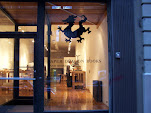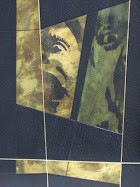 After a crazy week in the bindery, completing 10 of my boxes for the ongoing challenge in 10 days(with the aid of plates in most cases.....more about that whenever "A" can get the pictures...didn't even have time to take any)I am taking the time to address tool and equipment maintenance.
After a crazy week in the bindery, completing 10 of my boxes for the ongoing challenge in 10 days(with the aid of plates in most cases.....more about that whenever "A" can get the pictures...didn't even have time to take any)I am taking the time to address tool and equipment maintenance.Paul from binderytools.com changed out the blades of the chopper, brought a new set, refinished a nipping press, and got me started stripping and replaning my 3 laying presses.
I had been waiting for the time to sort out the laying presses, due to the fact that all 3 had been covered with a layer of varnish...the large one was sprayed(including the wooden screws!!!)with a layer of Polyurethane.
All I will say about that is, if you are going to buy bookbinding equipment, depending on where you get it you will have to ask how the wood has been treated or finished.
In short the polyurethane rubbed off the cheek leaving an uneven surface, scorched the bottom of the plough, the pins eventually becoming clogged-up with small flakes of a white residue, it remained idle for almost a year.
I took great satisfaction in taking them all apart and sanding the cheeks back to the raw wood, and applying a treatment of linseed oil.
so to recap...DO NOT VARNISH YOUR BOOKBINDING EQUIPMENT...FROM BACKING BOARDS AND LAYING PRESSES, TO SEWING FRAMES...
The box challenge continues a pace with some new titles(hunter s.thompson, martin luther king, more fitzgerald)and a new deadline......20 by december 31st, so watch this space .......











